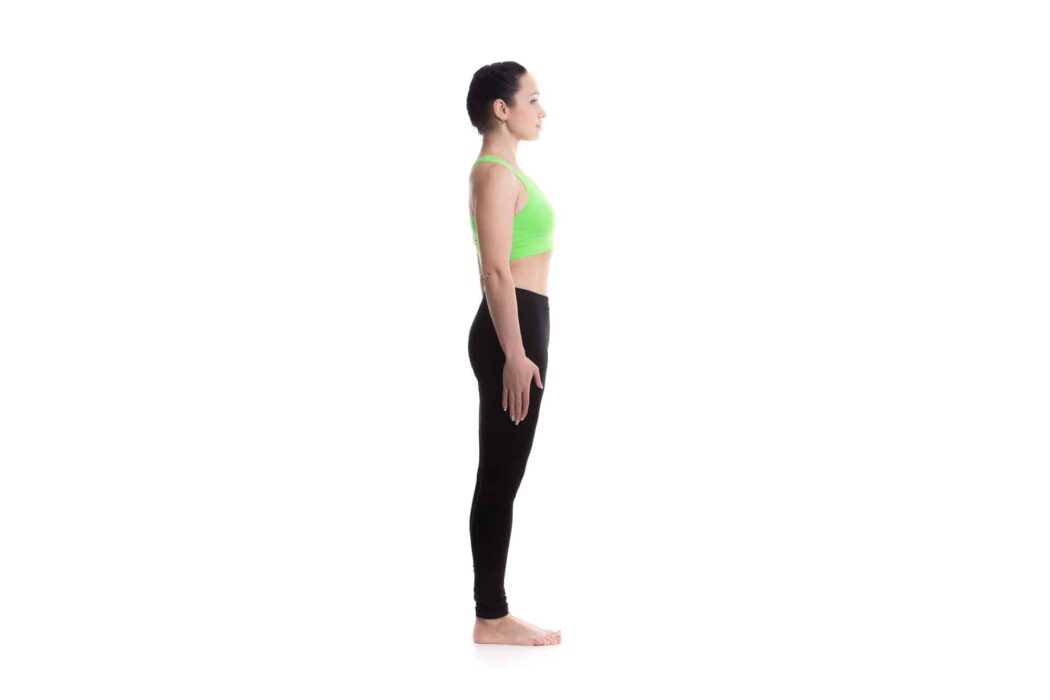
tada = mountain
Goals: proper posture
Although this pose seems to be very simple, it helps improve the body adjustment necessary for the correct position of bones and joints. You’re going to need this pose as a part of many sequences, no matter what yoga style you practice.
How to Get Into It
- Step on the mat; your toes touch each other, heels are beneath your hips.
- Take a moment to notice your soles on the floor and distribute the weight evenly on the inner and outer sides of the soles.
- Engage quads and keep the legs engaged, rotate your things inward, and align your kneecaps with toes (toes and kneecaps face in one direction)
- Tilt your tailbone, ensure your lower back is not arching. Engage your abdomen muscles to support the lower back in the neutral position.
- Relax your shoulders and pull your shoulder blades together and widen the collarbones to open the chest more.
- Place your arms on the sides of your core. You can slightly push your fingers and palms down and point the head crown up, stretching the sides of the neck more.
After these checkpoints are set, scan your body with attention slowly, starting from soles up to the head crown. Try to maintain awareness and relax the areas that feel tense.
Warrior 3 Tips For Perfect Balance
Keep this pose for 5-10 breath cycles if you do it as a separate asana, 2-3 cycles – if done within any sequence (for example, as a part of Sun salutation).
Benefits
- One of the basic poses for beginners to start working on better posture. Proper alignment in the pose trains your body to stay in the form close to the natural healthy position of your joints.
- It improves whole-body awareness and helps to stay focused inside the practice. In Tadasana, you can feel from inside how the aligned position of your joints and bones feels. In this way, you improve proprioception (the ability of your brain to perceive the body’s position in the space).
- Strengthens legs, ankles, and upper back.
- Builds proper weight distribution and grounding for standing positions such as Warrior, Tree pose etc.
Safety
In most cases, Mountain pose doesn’t have any precautions and is safe for all to do. Still, listen to your body signals and stop doing Tadasana if you feel dizzy throughout the practice.
Modifications
You may want to place your soles a bit wider for more stability, making the asana easier.
To get it challenging, try to close your eyes as you stand.
Common Mistakes
Rushing In\Out the Pose
Many newcomers in the yoga class tend to rush in the pose as they believe it is as simple as it looks. But taking enough time to go through all body and connecting the attention and the muscle feeling is the key to creating the sensory connection between your brains and muscles.
Losing Focus
Another common mistake is a distraction. Taking this pose as a break between asanas, some yogis use this time to put clothes in order or gaze around the yoga class.
Losing focus on the body in this position, you risk being trapped unintentionally in your habitual unhealthy movement patterns.
Incorrect Thigh Rotation
Soles and thigh alignment helps to coordinate the position of joints and spine. The healthiest variant is the inward thigh rotation. If that is too difficult for you, get a block and squeeze it between your thighs to allow your body to “remember” this position.